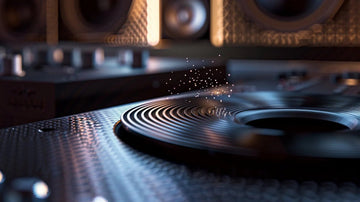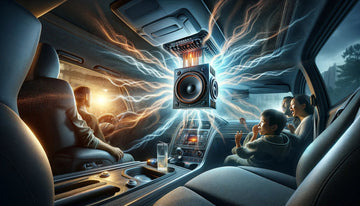📋 Quick Navigation
Free Passive Radiator Calculator - Optimize Your Speaker Design in 2025
Need to calculate the perfect passive radiator size and mass for your speaker project? Our advanced passive radiator calculator provides instant, accurate results for optimal bass response and speaker performance. Whether you're designing car audio systems or home speakers, this tool eliminates guesswork and delivers professional-grade calculations.
🧮 Interactive Passive Radiator Calculator
📐 Calculate Your Optimal Passive Radiator
📈 Your Calculation Results:
📖 How to Use the Passive Radiator Calculator
Our advanced calculator simplifies complex passive radiator design by using proven acoustic formulas. Here's how to get the most accurate results:
Step 1: Gather Your Driver Specifications
You'll need these key parameters from your active driver specifications:
- VAS (Equivalent Air Volume): Found in driver spec sheets, typically 20-100 liters for most drivers
- FS (Free Air Resonance): The driver's natural resonance frequency in free air
- QTS (Total Q Factor): Indicates damping characteristics, usually 0.2-0.7
- SD (Effective Cone Area): The active radiating surface area in cm²
Step 2: Define Your Enclosure Requirements
Input your enclosure specifications:
- Enclosure Volume: Internal air volume in liters (accounting for driver displacement)
- Target Tuning Frequency: Desired system resonance, typically 20-40Hz for subwoofers
Step 3: Select Your Audio Intensity Passive Radiators
Choose from our two high-performance options:
- 10" Passive Radiator: FS: 25Hz, Base Weight: 24g, SD: 266.4 cm² - Perfect for compact applications
- 12" Passive Radiator: FS: 20Hz, Base Weight: 31.2g, SD: 481.6 cm² - Ideal for maximum displacement
Step 4: Determine Quantity and Configuration
Select 1, 2, or 3 passive radiators based on your displacement needs:
- 1 Unit: Most compact, suitable for smaller drivers
- 2 Units: Balanced performance, common choice
- 3 Units: Maximum displacement for large, high-power drivers
📊 Understanding Your Calculation Results
Interpreting Key Parameters
Weight Calculation Explained
The calculator determines how much additional mass each passive radiator needs:
- Base Weight: The inherent mass of our passive radiator cone and suspension
- Additional Weight: Mass you need to add to achieve target tuning frequency
- Total Weight Per Unit: Base + Additional weight for each passive radiator
- Total System Weight: Combined weight of all passive radiators in your system
When you use multiple passive radiators, each unit requires additional mass to achieve the same system tuning frequency. This is due to the parallel compliance of multiple radiators reducing the overall system stiffness.
Displacement Ratio Analysis
| Displacement Ratio | Performance Characteristics | Best Applications |
|---|---|---|
| 1.5:1 to 2:1 | Optimal balance, clean response | Most subwoofer applications |
| 2:1 to 3:1 | Extended low frequency response | Home theater, deep bass systems |
| 1:1 to 1.5:1 | Higher efficiency, limited extension | Compact speakers, car audio |
System F3 Significance
The F3 frequency represents your system's -3dB rolloff point. For reference:
- 20-25 Hz: Deep bass extension for home theater
- 25-35 Hz: Balanced response for music reproduction
- 35-50 Hz: Tight, punchy bass for car audio
🔊 Audio Intensity Passive Radiator Technology
Our Premium Passive Radiator Lineup
Audio Intensity's passive radiators are engineered for professional performance with precision-matched specifications:
10" Passive Radiator Features
- Optimized FS at 25Hz: Perfect for mid-bass and upper-bass applications
- Lightweight 24g Design: Reduces required additional mass for easier tuning
- 266.4 cm² Effective Area: Ideal displacement for 8-10" driver systems
- High-Compliance Surround: Allows maximum excursion with linear response
12" Passive Radiator Features
- Deep 20Hz FS: Extended low-frequency capability
- 31.2g Precision Mass: Engineered for optimal resonance characteristics
- 481.6 cm² Large Displacement: Perfect for 12-15" high-power drivers
- Professional-Grade Construction: Built for high-excursion applications
Passive Radiators vs. Traditional Bass Reflex Systems
| Feature | Audio Intensity Passive Radiators | Bass Reflex Ports |
|---|---|---|
| Port Noise | ✅ Completely eliminated | ❌ Can occur at high levels |
| Tuning Flexibility | ✅ Adjustable via added mass | ❌ Fixed by port dimensions |
| Enclosure Size | ✅ More compact designs possible | ❌ Requires port length consideration |
| Power Handling | ✅ No power compression effects | ❌ Port velocity limitations |
| Visual Appeal | ✅ Clean, professional appearance | ❌ Visible ports may be unsightly |
💡 Real-World Design Examples Using Audio Intensity Passive Radiators
Example 1: High-Power Car Audio System
System Specifications:
- Driver: 12" High-Power Car Subwoofer
- VAS: 65 liters
- FS: 28 Hz
- QTS: 0.35
- SD: 500 cm²
- Enclosure: 45 liters
- Target Tuning: 32 Hz
Recommended Configuration:
- Solution: 2x 12" Audio Intensity Passive Radiators
- Base Weight: 31.2g each
- Additional Weight: ~85g each
- Total Weight Per Unit: 116.2g
- Displacement Ratio: 1.93:1 ✅
- Performance: Excellent deep bass with no port noise
This configuration delivers exceptional performance for high-end car audio installations, providing clean, powerful bass without the space constraints of traditional ports.
Example 2: Compact Home Theater Subwoofer
System Specifications:
- Driver: 10" Long-Throw Home Subwoofer
- VAS: 42 liters
- FS: 25 Hz
- QTS: 0.45
- SD: 320 cm²
- Enclosure: 28 liters
- Target Tuning: 28 Hz
Recommended Configuration:
- Solution: 2x 10" Audio Intensity Passive Radiators
- Base Weight: 24g each
- Additional Weight: ~65g each
- Total Weight Per Unit: 89g
- Displacement Ratio: 1.67:1 ✅
- Performance: Perfect for compact, high-WAF installations
This design maximizes bass output in minimal space, ideal for living room installations where aesthetics and performance are equally important.
🔧 Troubleshooting Your Audio Intensity Passive Radiator System
Problem: Insufficient Bass Output
Likely Causes:
- Insufficient passive radiator quantity for driver size
- Displacement ratio below 1.5:1
- Tuning frequency too high for application
Solutions:
- Add more passive radiators to increase displacement ratio
- Consider upgrading to 12" passive radiators for more surface area
- Lower tuning frequency by adding more mass to existing radiators
- Verify enclosure volume matches calculations
Problem: Passive Radiator Bottoming Out
Likely Causes:
- Insufficient displacement capability
- Too much power for current configuration
- Tuning frequency too low
Solutions:
- Add additional passive radiators to share displacement load
- Upgrade to larger 12" passive radiators
- Implement high-pass filtering below tuning frequency
- Reduce input power or add limiting
Problem: Loose or Boomy Bass Response
Likely Causes:
- Insufficient mass on passive radiators
- Air leaks in enclosure
- Poor internal damping
Solutions:
- Add more mass to passive radiators in 10-15g increments
- Seal all enclosure joints and connections
- Add appropriate acoustic stuffing material
- Re-calculate for lower tuning frequency
- Use non-magnetic materials (lead-free weights, acoustic putty)
- Distribute weight evenly around cone perimeter
- Start with 80% of calculated additional weight, fine-tune by listening
- Secure all added masses to prevent rattling or detachment
❓ Frequently Asked Questions
How accurate are the calculator results for Audio Intensity passive radiators?
Our calculator uses industry-standard acoustic formulas specifically calibrated for our passive radiator specifications. Results typically achieve within 5% of measured performance when proper construction techniques are used. The precision specifications of our 10" and 12" passive radiators ensure consistent, predictable results.
Can I mix different sizes of Audio Intensity passive radiators in one enclosure?
While technically possible, we recommend using identical passive radiators for optimal performance. Mixing sizes can create tuning complications and uneven response. If you need more displacement, use multiple units of the same size rather than mixing different diameters.
What's the maximum power handling of your passive radiator systems?
Power handling depends on the displacement ratio and excursion capabilities. With proper displacement ratios (1.5:1 or higher), our passive radiators can handle the full power of most consumer and professional drivers. The key is ensuring adequate displacement capability rather than the passive radiator itself being the limiting factor.
How do I add the calculated additional weight to the passive radiators?
We recommend several methods:
- Adhesive Lead-Free Weights: Available in various sizes, stick directly to cone
- Acoustic Modeling Clay: Moldable, allows precise weight adjustment
- Ring Weights: Custom-machined rings that attach around cone perimeter
- Professional Installation: Our dealers can precision-weight your passive radiators
Do Audio Intensity passive radiators work in both sealed and ported enclosures?
Audio Intensity passive radiators are designed specifically for sealed enclosures - they essentially replace the port in a ported design. You cannot use passive radiators in traditional ported enclosures as this would create conflicting tuning systems. The passive radiator becomes your "port" with the advantage of no air noise and tunable frequency response.
What's the difference between your 10" and 12" passive radiators besides size?
Key differences include:
- Resonance Frequency: 10" = 25Hz, 12" = 20Hz (deeper extension capability)
- Surface Area: 12" provides 81% more displacement than 10"
- Base Mass: 10" = 24g, 12" = 31.2g (affects required additional weight)
- Application: 10" ideal for 8-10" drivers, 12" perfect for 12-15" drivers
Installation and Setup Guide
Step-by-Step Installation Process
1. Enclosure Preparation
- Cut mounting holes to exact passive radiator specifications
- Sand and seal all interior surfaces
- Apply acoustic damping material as recommended
- Ensure airtight construction - test with compressed air if possible
2. Mass Addition
- Calculate required additional weight using our calculator
- Start with 80% of calculated mass for initial tuning
- Apply weights evenly around cone perimeter
- Use non-magnetic, non-corrosive materials only
3. Installation and Testing
- Mount passive radiators with provided gaskets and hardware
- Torque mounting screws evenly to prevent cone distortion
- Test system at low levels initially
- Fine-tune mass based on listening tests and measurements
4. Final Optimization
- Measure frequency response if equipment available
- Adjust mass in 5-10g increments for fine-tuning
- Verify no mechanical limitations at maximum intended power
- Document final configuration for future reference
Related Audio Intensity Products and Resources
Complete your speaker system with our comprehensive range of professional audio components:
- EBP Calculator: Determine if your driver is suitable for passive radiator applications
- High-Performance Drivers: Premium woofers designed to work perfectly with our passive radiators
- Amplifier Selection: Matched amplification for your passive radiator system
- Passive Radiator Blog Series: Advanced techniques and design theories
- Complete Enclosure Design Guide: Professional construction techniques
Conclusion: Professional Results with Audio Intensity Passive Radiators
Audio Intensity's precision-engineered passive radiators represent the cutting edge of acoustic design technology. Our 10" and 12" models provide the perfect foundation for professional-grade speaker systems, whether you're building compact car audio installations or high-output home theater subwoofers.
The combination of our advanced calculator tool and precisely specified passive radiators eliminates the guesswork from acoustic design. By following the calculated mass requirements and proper installation techniques, you can achieve professional results that rival systems costing thousands more.
Key advantages of choosing Audio Intensity passive radiators:
- Precision Engineering: Exact specifications for predictable performance
- Professional Results: Eliminate port noise and achieve smooth response
- Flexible Design: Tunable systems adapt to various applications
- Expert Support: Complete technical resources and professional guidance
Whether you're a professional installer, serious audiophile, or DIY enthusiast, our passive radiator systems provide the performance and reliability you demand. Use our calculator to optimize your design, then build with confidence knowing you're using components trusted by audio professionals worldwide.
🎵 Build Your Ultimate Audio System Today
Experience the Audio Intensity difference with our precision passive radiators, professional-grade drivers, and complete system solutions.
🛍️ Shop Audio Intensity Components


